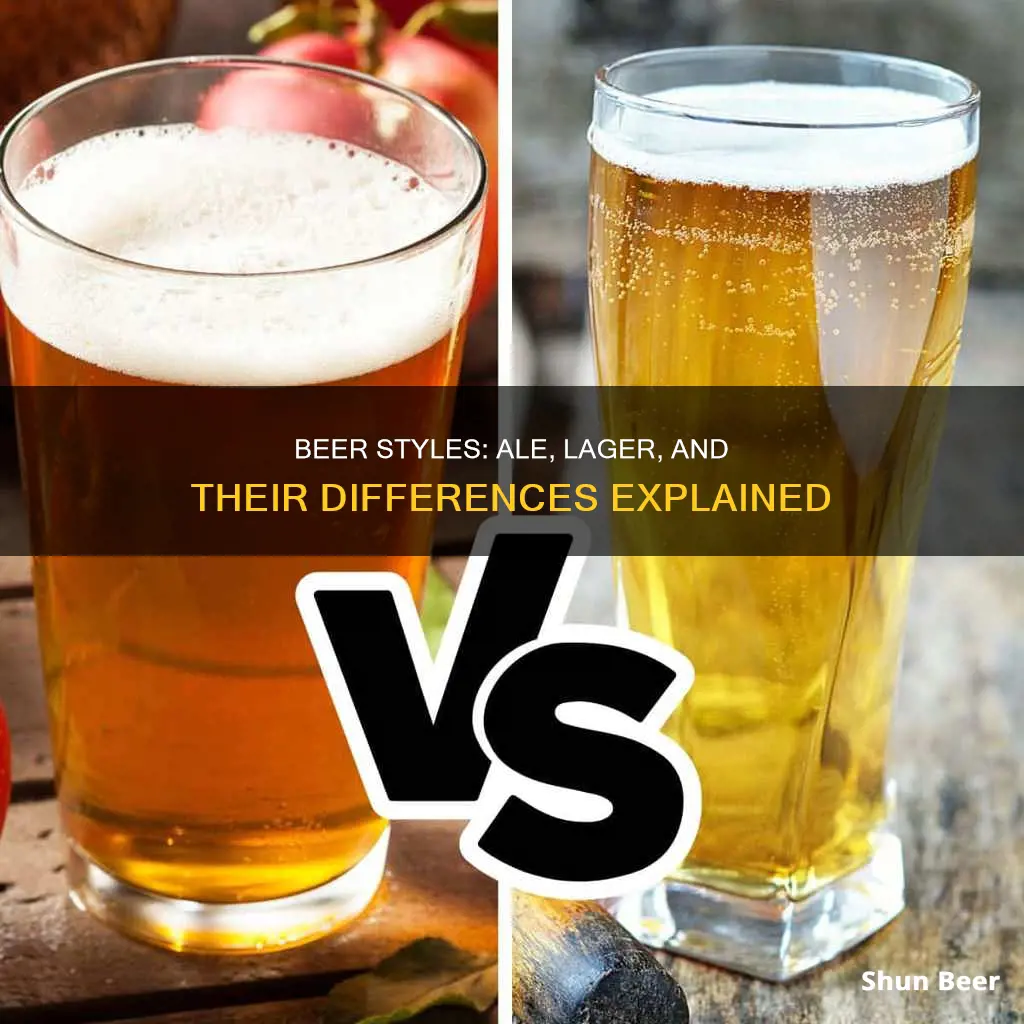
Beer lovers, rejoice! There are two main categories of beer: ale and lager. All beers are classified as either an ale or a lager, and the distinction is made based on the fermentation technique and yeast used in brewing. Ales are fermented with top-fermenting yeast at warm temperatures (60˚–75˚F), while lagers are fermented with bottom-fermenting yeast at cold temperatures (35˚–55˚F). Ales tend to be stronger and sweeter in flavour, while lagers tend to be crisp and clean.
| Characteristics | Values |
|---|---|
| Fermentation technique | Ales are top-fermented at warm temperatures (60°F–75°F). Lagers are bottom-fermented at cold temperatures (41°F–55°F). |
| Fermentation duration | Ales can be fermented and aged in 3–5 weeks. Lagers can take up to 6–8 weeks. |
| Yeast | Ales are made with Saccharomyces cerevisiae. Lagers are made with Saccharomyces pastorianus. |
| Taste | Ales are sweeter and fuller-bodied with a bitter edge. Lagers are smoother with crisp notes. |
| Colour | Lager beers tend to be lighter in colour than ales. |
What You'll Learn
- Ales are fermented with top-fermenting yeast at warm temperatures
- Lagers are fermented with bottom-fermenting yeast at cold temperatures
- Ales can ferment and age in a shorter time than lagers
- Ales tend to be sweeter and fuller-bodied than lagers
- Lagers are smoother with crisp notes from cold fermentation

Ales are fermented with top-fermenting yeast at warm temperatures
The specific strain of yeast typically used for ale fermentation is called ale yeast or Saccharomyces cerevisiae, which is the same species of yeast used in baking bread. This yeast ferments the sugar into alcohol at the top of the fermentation tank, near the surface of the wort. This positioning allows brewers to skim the yeast from the wort and reuse it in subsequent batches.
The warm fermentation of ales results in a fruitier, more complex flavour profile compared to lagers. Ales tend to have strong fruity and spicy flavours that balance the malt and hops. The warmer temperatures also encourage the production of aromatic compounds, giving ales their distinctive character.
In addition to the choice of yeast and fermentation temperature, the longer aging process of ales contributes to their unique characteristics. Ales can be ready to drink in as little as three weeks, while lagers typically require up to six to eight weeks for fermentation. This faster fermentation process has historically made ales more common among craft brewers, especially those with limited fermenter space.
Alcohol Content in Beer: State-by-State Differences
You may want to see also

Lagers are fermented with bottom-fermenting yeast at cold temperatures
The most significant difference between ales and lagers lies in the fermentation process and the type of yeast used. Ales are fermented with top-fermenting yeast at warm temperatures, typically between 60°F and 70°F (16°C to 21°C). On the other hand, lagers are fermented with bottom-fermenting yeast at cold temperatures, usually in the range of 41°F to 50°F (5°C to 10°C).
Lager yeast, known as Saccharomyces pastorianus, is a hybrid species resulting from the combination of Saccharomyces cerevisiae and Saccharomyces eubayanus, a wild yeast native to Patagonia. This unique blend gives lager yeast the ability to thrive in colder environments, which is essential for lager fermentation.
The choice of fermentation temperature has a significant impact on the flavour profile of the beer. Ales, with their warmer fermentation, tend to have more pronounced flavours due to the increased production of esters and phenols during warm fermentation. Lagers, on the other hand, have a "crisper" and smoother taste with fewer pronounced flavours due to the slower, cold fermentation process.
The temperature also influences the fermentation time. Ales, with their faster-acting yeast and warmer temperatures, can complete fermentation in as little as 7 days, making them a popular choice for craft brewers. Lagers, on the other hand, typically require 4 to 8 weeks for fermentation due to the slower metabolic activity of the yeast at lower temperatures.
Additionally, the amount of yeast used in lager fermentation is crucial. A lager fermentation is slower, and a larger quantity of healthy yeast is required to ensure sufficient metabolic activity and prevent the production of undesirable compounds. Brewers pay close attention to yeast health, providing proper nutrition and oxygenation to promote a clean and complete fermentation.
Ginger Ale vs Ginger Beer: What's the Difference?
You may want to see also

Ales can ferment and age in a shorter time than lagers
Ales and lagers are two main categories of beer. While they can be differentiated by their fermentation technique, yeast used, flavour, and colour, the fundamental difference lies in their fermentation processes. Ales are fermented with top-fermenting yeast at warm temperatures (60–75°F), while lagers use bottom-fermenting yeast at cold temperatures (41–55°F).
The warm fermentation of ales allows for a shorter fermentation and ageing process, typically taking two to five weeks. The top-fermenting yeast works vigorously in these warm temperatures, allowing for a relatively short fermentation time. The yeast ferments the sugar into alcohol at the top of the fermentation tank, and brewers can skim the yeast from the wort for reuse in other batches.
On the other hand, lagers, with their cold fermentation, take much longer to ferment, typically requiring four to eight weeks. The cooler temperatures slow down the yeast's metabolism, resulting in a longer fermentation duration. The bottom-fermenting yeast sinks to the bottom of the fermentation tank after consuming all the sugars to form alcohol.
The difference in fermentation time between ales and lagers has significant implications for the beer industry, particularly for small craft breweries. Ales, with their shorter fermentation time, are more common among craft brewers as they can produce beer more quickly and with less fermenter space. This is especially relevant for small breweries with limited tank space, who may not be able to afford to have tanks occupied for long periods. Thus, the ability of ales to ferment and age in a shorter time makes them a more convenient and popular choice for craft brewers.
Pasteurized vs Unpasteurized Beer: What's the Difference?
You may want to see also

Ales tend to be sweeter and fuller-bodied than lagers
The colder temperatures used in lager fermentation slow down the fermentation process and produce less foaming. Lagers generally have a 'cleaner' taste, with a smooth, crisp flavour profile and a lower fruitiness level than ales. This allows the malt and hops to be more noticeable in lagers.
While the fermentation technique and yeast used are the primary distinctions between ales and lagers, there are also some general differences in colour and alcohol content. Lager beers tend to be lighter in colour, although there are exceptions, such as porters and stouts, which can be quite dark. Ales, on the other hand, tend to be darker, although there are also lighter ales such as pale ales and IPAs.
In terms of alcohol content, ales and lagers can vary widely within their respective categories. However, it is worth noting that lagers tend to have a lower alcohol content than ales.
Heineken's Unique Brewing Process: What Sets it Apart?
You may want to see also

Lagers are smoother with crisp notes from cold fermentation
The two main categories of beer are ales and lagers. The difference between the two is determined by the fermentation technique and yeast used in brewing. Ales are fermented with top-fermenting yeast at warm temperatures (60–70˚F), while lagers are fermented with bottom-fermenting yeast at cold temperatures (35˚–50˚F).
Lagers are known for their smooth and crisp notes, which can be attributed to the cold fermentation process. This slow fermentation at lower temperatures results in a cleaner flavor profile compared to ales. The extended cold storage, also known as lagering, makes lagers more shelf-stable than ales, which is why most beers around the world are of the lager variety.
The cold fermentation of lagers suppresses many by-products of yeast fermentation, resulting in a beer that highlights the malt and hops flavours. This process gives lagers their characteristic mellow taste and lower alcohol content.
Lager yeast, or Saccharomyces pastorianus, is more comfortable with colder temperatures and can metabolize complex sugars that ale yeast cannot. This ability contributes to the unique flavour profile of lagers.
The longer fermentation time of lagers, typically four to eight weeks, also contributes to their smooth and crisp qualities. This extended period allows for a more thorough maturation process, where the yeast cleans up by-products like diacetyl (butterscotch flavour) and acetaldehyde (green apple flavour).
The cold conditioning phase, an essential step in lager brewing, further enhances the smoothness and crispness of the beer. During this phase, proteins, polyphenols, and hop polyphenols precipitate out of the solution, resulting in a milder hop bitterness. Additionally, the yeast continues to work during cold conditioning, reducing any remaining diacetyl and sulfur compounds while maturing the flavour.
In summary, the smooth and crisp notes characteristic of lagers are a result of the cold fermentation process. The slower metabolism of yeast at lower temperatures, combined with the extended maturation and cold conditioning phases, contribute to the clean and mellow flavour profile that lagers are known for.
Draught vs Beer: What's the Difference?
You may want to see also
Frequently asked questions
The main difference between a beer ale and lager is the type of yeast used in the fermentation process. Ale is brewed with a different type of yeast, which ferments at the top of the tank and prefers warmer conditions. Lager yeast, on the other hand, settles at the bottom of the tank and works its magic at cooler temperatures.
Ales tend to be sweeter, more complex, and fruitier than lagers. Lagers have a smoother, cleaner, and crisper taste, allowing the malt and hops to be more noticeable.
Some popular types of ales include brown ale, pale ale, Indian pale ale (IPA), Belgian ale, and stout.
Some popular types of lagers include pilsners, bocks, and Vienna lagers.







